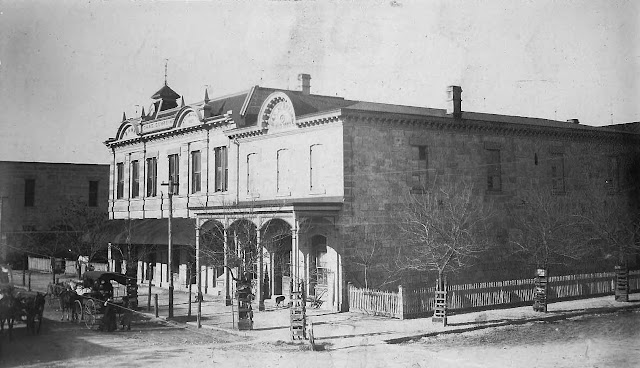 |
| Charles Schreiner Company, around 1900 This store stood at the corner of Water and Earl Garrett Streets. Click on any image to enlarge |
There are some folks too young to remember shopping in a general store, younger folks who may assume browsing on a retailer’s website, or flipping through its catalog, is similar to that old experience. Though I remember shopping in general stores, even I cannot imagine what it was like to shop in a store like Schreiner’s was at the turn of the last century. The nearest modern-day store which compares to that type of shopping, in my opinion, is probably Gibson’s.
Recently, among the items given to me by Sandy and Jon Wolfmueller, I found two photographs of the interior of the Schreiner department store, taken around 1900. These are two photographs I had never seen before, and they’re fascinating.
Schreiner’s was a department store on the corner of Water and Earl Garrett streets. It started as Faltin & Schreiner on Christmas Eve, 1869, in a small 16 x 18 foot frame building which stood about where the Charles and Magdalena Schreiner home stands today.
 |
| Dry goods department, Schreiner's, circa 1900 |
At the back of the shed was a cellar, used to store "barrels of coal oil, beer, whiskey and molasses."
There was a long counter running the length of the building which "described an L at the back to cut off a small space that served as an office, and to shelter, at its base, barrels of sugar, coffee, rice, lard, and dried fruit."
Haley continues: "On the back wall was a stock of groceries, while the long counter to the side cut off the dry goods that lay in assorted bolts of calico, jeans and hickory on rough shelves along the wall. On the opposite side, harness and saddles hung on hooks at the front, and wooden ware -- buckets, kegs, and tubs -- hung on the wall behind the stove."
The merchant of this store also stocked "an assortment of patent medicines -- Jane's Tonic, Pain-Killer, Ayer's Pills, Hostetter's Bitters, Vermifuge and other concoctions." Most customers usually got well in spite of these remedies.
Whiskey was a big seller, and was stocked in three or four grades, some selling for as low as fifty and seventy-five cents a quart; others as high as a dollar. I'm not completely sure all "grades" of whiskey were not drawn from the same barrel.
The store grew from that little frame building, moving to a new stone building to which additions were made over the next 75 years. It was as if the first building grew like a living thing, not with a long-range plan, but adding space as it was needed.
 |
| Housewares department, Schreiner's, circa 1900 |
The dry goods department photograph shows customers in fancy hats, shopping at a counter on the left, lined with fabrics of many different colors. Hat boxes line the wall above the display. Little stools attached to the long counter are there for the convenience of the shoppers.
In the rear of the building a little mezzanine can be seen, with a stairway on the left. Sunlight brightens the faces of the shoppers and clerk; bright sunshine can be seen above and below the mezzanine at the rear of the store. In the foreground a display case is filled with what appears to be scarves and handkerchiefs, and fancy pitchers, glasses, and serving trays are shown above.
All along the right wall are boxes of shoes, from floor to ceiling. A ladder/stair, attached to a rail, can be rolled up and down the inventory of shoes. Just to the right of the post in the center of the image is a display of ribbons.
The other photograph, of the housewares department, I see everything from galvanized pails to lamp chimneys. A selection of fishing poles appears to be dangling from the ceiling. There are brooms, large ceramic crocks, boxes of ‘Silk Soap,’ alarm clocks, and cleaning supplies. A doorway can be seen at the rear of the room, and, from the ceiling, a row of kerosene lamps are shown; I think those lamps were not on sales display, but used for lighting the room.
I can almost imagine shopping there. I think one of those fishing poles is calling my name.
Until next week, all the best.
Joe Herring Jr. is a Kerrville native who should go fishing more often. This column originally appeared in the Kerrville Daily Times January 8, 2022.
Though this newsletter is free, it isn't cheap. You can help by sharing it with someone, by forwarding it by email, or sharing it on Facebook. Sharing is certainly caring. (I also have two Kerr County history books available online, with free shipping!)


I remember the store from the early 50's. Train tracks ran to the back lot where farm implements and feed were sold out of old wooden warehouses. Sometimes goats and chicks were available. The wet floors in the grocery section and the creaky oak flooring in the dry goods section are my fond memories for some unknown reason. I guess I was closer to the floor back then so they got most of my attention.
ReplyDelete